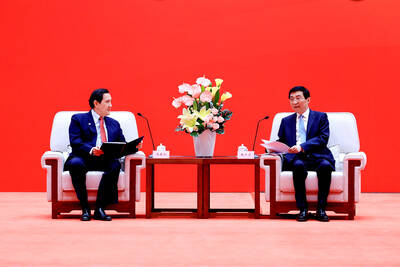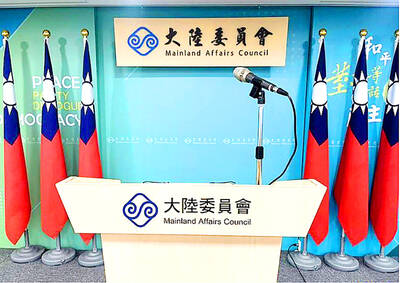Smilies are so 1990s. Emoticons have evolved to another level in Taiwan after users started making their own animated GIF files and swapping them through chat programs such as the popular MSN Messenger.
Emoticons have an extra twist in this country -- instead of a parenthetical aside, emoticons are now replacing Chinese characters as a part of the sentence.
And while Chinese language academics see this trend, along with the "martian language" (火星文) phenomenon -- in which letters and numbers are used to create the sounds of words -- as another sign of the fallen state of the Chinese language among the young, users can't seem to get enough of the elaborate emoticons for every occasion.
Indeed, it's been more than 25 years since US computer scientist Scott Elliot Fahlman came up with the idea of stringing together a colon, a dash and a parenthesis sign to make a "smiley face."
According to Fahlman's original post on the Carnegie Mellon online bulletin board on Sept. 19, 1982, he thought the sequence of characters could function as a "joke marker" for online conversations that get too heated.
"Read it sideways," advised Fahlman in the original post, retrieved after a massive verification effort digging through old archives.
Little could Falhman have anticipated that more than a quarter of a century later, his flippant suggestion could become a major component of digital communication for the Web-savvy citizens of a far-away country -- Taiwan.
While standard emoticons such as the "smiley" and the "winkey" have taken the world by storm and various software and chat programs now automatically render them into the ubiquitous yellow "smiley" face, the use of such bog-standard emoticons could simply mark one out as behind the times in this country, where the rise of custom animated emoticons have elevated the use of "smilies" to a major component of conversations rather than an aside.
"It all started three years ago, when an update of Microsoft's chat program Instant Messenger begin to support custom emoticons," said blogger Nokimi, who works as a Web site project manager.
Messenger, and other chat programs, have become ubiquitous in Taiwan and along with them the emoticons and animated emoticons that users can easily create and upload as GIFs.
"I would say that everybody I know who uses the 'net in Taiwan is also on MSN," Nokimi said.
He estimated that he has more than 30 online chat conversations a day, with friends, work colleagues and clients.
"At it's peak, my collection had more than 300 emoticons for my IM [Instant Messenger]," said "Annie," a reporter in Taipei who declined to be named for the purpose of this interview.
"Whenever I had a spare moment, I would go online to download some more. I wanted to have an emoticon that was fitting for every occasion. Unfortunately a virus that necessitated wiping my hard drive meant that I've had to start from scratch again," she said.
The world of animated emoticon has even produced its own superstar -- Onionhead. The character, with its distinctive spike of hair, features in a series of more than 70 animated emoticons, allowing users to express everything from getting sleepy, wiping sweat off their brow to laughing while wielding a hidden dagger.
Amy Chang of the Full Tone Art Co said, Onionhead's creator, "Ethan," is now working on new Onionhead emoticons and desktop pictures full-time. Although the downloads are free, Onionhead's popularity brings lucrative licensing opportunities.
The character is considered so popular among the young that the Planned Parenthood Association of Taiwan featured a specially commissioned Onionhead cartoon on the packaging of their condoms.
Onionhead's appeal has also reached overseas.
"It's hard to measure the popularity of Onionhead since most people swap them through IM rather than download them through our site," Chang said. "But we have licensed to merchandisers in China, Hong Kong and Macau."
However, there are complaints that the craze for emoticons has gone too far.
"I'm OK with an emoticon at the end of a sentence to highlight one's feelings, I'm even fine with emoticons that replace Chinese characters with the same character in a cutesy font," Nokimi said. "However, I cannot stand people who replace characters, or even multiple characters, with pictures."
This practice, known as "picture language" (
When Annie types the Chinese character for "no" her friends see a GIF animation of a man shaking his head.
Each sentence she types in IM might automatically bring up three or four such "picture language" icons.
"Friends have complained that I use too many icons when I chat on MSN," Annie said. "However, I don't think it's that hard to guess what I'm saying given the context. If they still can't figure it out, they can always right click to find out what the picture is meant to say."
"That's exactly what I find the most obnoxious about picture language users," Nokimi said. "Their desire to try something novel wastes my time."

BUILDUP: US General Dan Caine said Chinese military maneuvers are not routine exercises, but instead are ‘rehearsals for a forced unification’ with Taiwan China poses an increasingly aggressive threat to the US and deterring Beijing is the Pentagon’s top regional priority amid its rapid military buildup and invasion drills near Taiwan, US Secretary of Defense Pete Hegseth said on Tuesday. “Our pacing threat is communist China,” Hegseth told the US House of Representatives Appropriations Subcommittee on Defense during an oversight hearing with US General Dan Caine, chairman of the Joint Chiefs of Staff. “Beijing is preparing for war in the Indo-Pacific as part of its broader strategy to dominate that region and then the world,” Hegseth said, adding that if it succeeds, it could derail

CHIP WAR: The new restrictions are expected to cut off China’s access to Taiwan’s technologies, materials and equipment essential to building AI semiconductors Taiwan has blacklisted Huawei Technologies Co (華為) and Semiconductor Manufacturing International Corp (SMIC, 中芯), dealing another major blow to the two companies spearheading China’s efforts to develop cutting-edge artificial intelligence (AI) chip technologies. The Ministry of Economic Affairs’ International Trade Administration has included Huawei, SMIC and several of their subsidiaries in an update of its so-called strategic high-tech commodities entity list, the latest version on its Web site showed on Saturday. It did not publicly announce the change. Other entities on the list include organizations such as the Taliban and al-Qaeda, as well as companies in China, Iran and elsewhere. Local companies need

CRITICISM: It is generally accepted that the Straits Forum is a CCP ‘united front’ platform, and anyone attending should maintain Taiwan’s dignity, the council said The Mainland Affairs Council (MAC) yesterday said it deeply regrets that former president Ma Ying-jeou (馬英九) echoed the Chinese Communist Party’s (CCP) “one China” principle and “united front” tactics by telling the Straits Forum that Taiwanese yearn for both sides of the Taiwan Strait to move toward “peace” and “integration.” The 17th annual Straits Forum yesterday opened in Xiamen, China, and while the Chinese Nationalist Party’s (KMT) local government heads were absent for the first time in 17 years, Ma attended the forum as “former KMT chairperson” and met with Chinese People’s Political Consultative Conference Chairman Wang Huning (王滬寧). Wang

CROSS-STRAIT: The MAC said it barred the Chinese officials from attending an event, because they failed to provide guarantees that Taiwan would be treated with respect The Mainland Affairs Council (MAC) on Friday night defended its decision to bar Chinese officials and tourism representatives from attending a tourism event in Taipei next month, citing the unsafe conditions for Taiwanese in China. The Taipei International Summer Travel Expo, organized by the Taiwan Tourism Exchange Association, is to run from July 18 to 21. China’s Taiwan Affairs Office spokeswoman Zhu Fenglian (朱鳳蓮) on Friday said that representatives from China’s travel industry were excluded from the expo. The Democratic Progressive Party government is obstructing cross-strait tourism exchange in a vain attempt to ignore the mainstream support for peaceful development